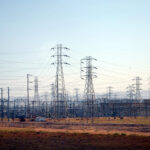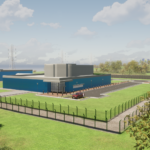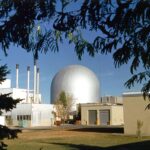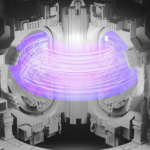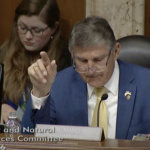The “scientization” of Yucca Mountain
By Dawn Stover | October 12, 2011
When I first stood atop Nevada’s Yucca Mountain more than 16 years ago, the Energy Department was spending about $1 million a day to assess the feasibility of safely storing spent fuel and high-level nuclear waste there. A steel-toothed tunneling machine had already begun chewing its way into the ridge, and some 300 scientists were on-site studying the area’s underground trickles, its porous rock, its lumbering desert tortoises, and a few reddish-black cinder cones that dotted the landscape below — the ominous tombstones of ancient volcanic eruptions.
There, overlooking Death Valley, a massive scientific effort to dispose of the nation’s hottest radioactive waste was finally under way. Today, however, the Yucca Mountain repository appears to be stone-cold dead. Not because scientists determined that the mountain could not safely contain high-level nuclear waste for 10,000 years or more, but rather because politics trumped science.
Government officials are often guilty of politicizing science. Egged on by business or religious interests, they cast doubt on the scientific evidence for a connection between tobacco and lung cancer, or between fossil fuels and climate change, or even between humans and our primate ancestors. Some scientific findings are suppressed, while others are manipulated or distorted beyond recognition. But in the case of Yucca Mountain, the reverse happened: Government officials “scientized” politics. They made decisions that were largely political but cloaked them in the garb of science.
In 2009, one of President Barack Obama’s first decisions after taking office was to scale back the Yucca Mountain program and devise “a new strategy toward nuclear waste disposal.” Obama told the Energy Department to withdraw its license application for Yucca Mountain, which had been submitted to the Nuclear Regulatory Commission in 2008.
“I think the President has come down on whether or not [Yucca Mountain] makes sense based on the science,” explained White House Press Secretary Robert Gibbs at a May 7, 2009, press conference. “I think there’s money in there to study particular options for how to deal with nuclear waste and do it in a way that’s based on sound science.”
Gibbs reiterated the emphasis on science in a briefing on February 16, 2010: “I think what has taken Yucca Mountain off the table in terms of a long-term solution for a repository for our nuclear waste is the science. The science ought to make these decisions.”
In 2002 the Energy Secretary issued a formal finding of Yucca Mountain’s scientific suitability, but the White House press corps didn’t question Gibbs on what “science” he was talking about. Instead, most coverage focused on Obama’s ties to Senate Majority Leader Harry Reid of Nevada, an Obama supporter who was heading into a tough re-election campaign in a state where there is widespread public opposition to Yucca Mountain. With the stroke of a pen, the president leveled a mountain of research that had taken 20 years and $10 billion to build. In its place he promised only to come up with a strategy “toward” disposal.
The president later appointed a Blue Ribbon Commission of 15 experts to study the nuclear waste problem for a year and report back with recommendations. But the Commission’s draft report, released on July 29, states that the commission was instructed not to render an opinion on Yucca Mountain’s suitability as a repository site. The commission asked the Energy Department to provide its justification for shutting down Yucca Mountain, and science explicitly was not part of Energy’s reasoning. Instead, the Energy Department claimed that because of Nevada’s objections to the site, the controversy would never be resolved. Meanwhile, Obama’s budget for fiscal 2012 has zeroed out the Yucca Mountain program.
Make no mistake: The scientization of Yucca Mountain began long before Obama took office — starting in the 1980s. The Energy Department initially identified nine potential repository sites and conducted environmental assessments for each. The department then nominated five of these sites for further study and, in 1986, recommended the three highest-ranking sites for detailed characterization: Yucca Mountain, Deaf Smith County in Texas, and the Hanford Site in Washington state. Hanford and Deaf Smith County were represented, respectively, by House Majority Leader Tom Foley and Speaker of the House Jim Wright. They joined forces and flexed their political muscle to remove their states from the short list, leaving only Nevada — a state whose representatives, including then-freshman Senator Harry Reid, had little clout. In 1987 Congress amended the Nuclear Waste Policy Act to focus solely on Yucca Mountain.
According to Senator James M. Inhofe’s 2006 report to the US Senate Committee on Environment and Public Works, which called Yucca Mountain “the most studied real estate on the planet,” the site was singled out because of its geohydrology, geochemistry, rock characteristics, tectonics, meteorology, costs, and socioeconomic impacts. But politics undoubtedly played a key role in the decision. In fact, the Nuclear Waste Policy Act had established a selection process for both a Western and an Eastern repository in the United States. But, in May 1986, President Ronald Reagan, facing possible midterm election losses by his party in key Eastern states, put the search for an Eastern site on hold.
It is still not completely clear whether Yucca Mountain would be a good place to bury radioactive waste. Despite the Energy Secretary’s 2002 seal of approval, there are legitimate scientific concerns about the suitability of the site. An independent US Nuclear Technical Waste Review Board said it had “limited confidence” in the Energy Department’s performance estimates for Yucca Mountain because of “gaps in data and basic understanding.” As Gary Taubes observed in Technology Review in 2002, “By choosing Yucca Mountain as the only option for a nuclear-waste facility, Congress put the DOE in an untenable position. In effect, it sent the department out to prove that Yucca Mountain would work as a repository, rather than to do a dispassionate analysis of whether it could work or was the best possible site.”
The ridiculous dance between politics and science eventually went full circle: First, Congress used politics to get the scientific answer it wanted. Two decades later, Obama leaned on science for the political result he wanted. When the music stopped, taxpayers and nuclear power plant operators found themselves right back where they started: with no waste-disposal solution in sight. Instead of being permanently stored in a geologic repository, or temporarily placed in dry-cask storage, most of the nation’s high-level nuclear waste continues to pile up in spent-fuel pools that are much more densely packed than those at Fukushima Daiichi.
As the Blue Ribbon Commission has reported to Obama, experience suggests that “any attempt to force a top-down, federally mandated solution over the objections of a state or community” is likely to be expensive, time-consuming, and ultimately unsuccessful. The construction of a permanent nuclear waste repository will require not only the backing of scientists and politicians but also the consent of a host community. In an era in which science and politics are often viewed with deep suspicion, it may be that the “communitization” of both is the most promising path forward.
Together, we make the world safer.
The Bulletin elevates expert voices above the noise. But as an independent nonprofit organization, our operations depend on the support of readers like you. Help us continue to deliver quality journalism that holds leaders accountable. Your support of our work at any level is important. In return, we promise our coverage will be understandable, influential, vigilant, solution-oriented, and fair-minded. Together we can make a difference.
Topics: Columnists, Nuclear Energy



